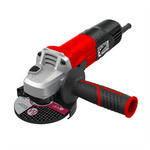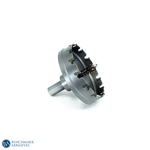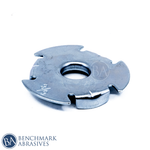
Types of Power Saws and Their Uses

Power saws are recognized for their wide range of applications in the industrial and craft industries. Modern electric or gas-powered saws are swifter and more effective, and are made in various styles to suit any need. Power saws can be used in a variety of ways to cut materials like wood, metal, tiles, bricks, and plastic. If you've ever used a power saw, you're aware that these tools feature rotating, reciprocating, or circulating blades.
These machines can be broadly divided into 10 major categories, each with a particular application and purpose. This article provides a comprehensive understanding of the 10 different power saw types, their applications, and their variants.
Choosing the Right Saw
Choosing the right power saw is essential for both precision and safety. Before making a purchase or starting a project, consider the type of material you'll be cutting, the specific cuts required—whether straight, angled, or curved—and the power source that best suits your workspace. Understanding these factors will guide you toward the most efficient and effective tool for your needs, preventing frustration and potential hazards.
General Power Saw Safety Tips
Staying safe is key, no matter which power saw you're using. Always wear safety glasses, hearing protection, and gloves. Make sure your workpiece is clamped down tight before you cut to avoid kickback. Don't force the saw; let the blade do the work.
Always unplug the saw before you change blades or do any maintenance. Keep your work area clean and free of clutter. And most importantly, read your saw's manual and get to know its safety features before you start.
10 Types of Power Saws and Their Applications
1. Circular Saws
This device includes an enclosed circular blade. The base of the machine is designed to clear away chopped material. Anyone can utilize a circular saw, a hand-held device that can be operated with either the left or right hand. Smaller in size and equipped with a variety of blades, circular saws simplify cutting through even tough metals like aluminum. The circular saw has a rotating blade that the operator must move across the workpiece to achieve the desired cut. The blade moves, and you can control its movement to make your desired cut.
Uses:
- Cutting through metals and building materials
- Cutting through wood and concrete
Beyond basic cuts, circular saws offer versatility through various blade types. A high-tooth-count blade provides smoother finishes for cabinetry, while a rougher, lower-tooth-count blade is ideal for fast framing cuts. Their portability makes them indispensable for on-site construction, quickly trimming lumber for deck building or cutting openings for windows and doors. DIYers frequently start their power tool collection with a circular saw, finding it an essential tool for numerous home improvement projects.
2. Table Saws
A table saw is a woodworking tool that has a saw blade mounted on an arbor. The user must move the workpiece across the blade to accomplish the desired cut, as the saw blade is fastened to an arbor. The cutting angle can be altered by adjusting the blade's angle. To provide maximum versatility, most table saws include various speed options.
Uses:
- Cross-cutting, mitering, and ripping wood
- Cutting through various materials like metal, plastic, and others
3. Chop Saws
A chop saw is a saw that has a fixed position on a swing arm that can be used to make straight cuts in material. It is primarily found in commercial workshops that work with such materials. To cut, you must press the blade onto the workpiece while holding the workpiece against a swing arm.
Uses:
- Ideal for cutting metal rods and pipes
- Best for cutting other materials that have been reinforced
4. Radial Arm Saws
Radial arm saws, popular before the miter saw, are stationary tools where the spinning blade and its head move across the workpiece to make cuts. Edges on other models can also be turned parallel to the fence to create rip cuts. The radial arm saws are popular because they have a slight negative angle on the blade hook. As a result, the blade ascends the material while cutting, improving safety.
Uses:
- Cutting big logs and wide planks of lumber
- Making accurate straight cuts
- Handling long cross-cutting projects
5. Miter Saws
The miter saw is a compact, portable tool perfect for precise angled cuts like crown molding, trim, and picture frames. Its accuracy and ease of use make it a favorite among carpenters and DIYers for finishing projects.
Uses:
- Creating precise angled cuts for trim and molding
- Cutting wood, plastic, and soft metal
- Ideal for framing and cabinetry
6. Tile Saws
This power saw can include a water-cooled blade, which effortlessly cuts intricate tiles while retaining precision. It uses its blade to cut the tile, and the water stream reduces dust and flying debris by cooling the blade during cutting. The saw's blade features a water jet stream that creates precise cuts and keeps the blade cool during tile cutting. Additionally, the water serves as a lubricant, ensuring accuracy. They are used to cut ceramic, porcelain, and natural stone tiles.
Uses:
- Cutting ceramic, porcelain, and stone tiles
- Creating precise and clean cuts for flooring and wall installations
7. Track Saws
These devices are also known as plunge saws. The track saw includes a spinning blade used for cutting. When the operator plunges the machine handle to the desired depth, the blade is exposed and guided by its fixed metal rail. The cut is then made at that consistent blade depth. To preserve accuracy, kickback is also eliminated during cutting.
Uses:
- Cutting plywood, MDF, and many other wood sheets
- Making precise cuts on large workpieces when a table saw just won't cut it.
8. Scroll Saws
The blade resembles a band saw in that it has two moving wheels, but instead of a continuous band, it employs a reciprocating blade. It's fine and sharp blade enables it to carve intricate curves. The machine comes with a removable reciprocating blade. Users can use it to cut any pattern they like after inserting the blade into a pilot hole. These saws also include a flexible arm that holds and guides the reciprocating blade.
Some variants of scroll saws may include a light to illuminate the working area. It also includes a dust blower nozzle to keep the work area clear of dust. The cutting angle can be changed by tilting the saw. Variable speed settings allow for greater control, enabling effortless cutting of complicated designs.
Uses:
- Creating intricate patterns and designs through precise cutting in wood, plastic, and thin metals.
- Ideal for artistic projects, fretwork, and detailed cutting where precision is key
9. Band Saws
Band saws are highly versatile tools known for their ability to make precise cuts on curved or irregular designs. Think of them as more powerful versions of jigsaws. Their operation involves rotating wheels that propel a continuous blade. You'll often find horizontal band saws in metalworking and metallurgy, and they can also cross-cut boards if sized appropriately. Interestingly, a band saw fitted with a miter gauge can even take on some functions typically handled by a miter saw. For tasks like resawing, the vertical band saw is the go-to choice.
Uses:
- Cutting curves and irregular shapes in wood
- Resawing lumber into thinner pieces
- Cutting various metals and plastics, depending on the blade
10. Reciprocating Saws
The reciprocating saw works by moving the blade back and forth. This sawing action allows you to quickly and easily cut workpieces. Both corded and cordless versions of this power saw are available; it typically runs on gasoline or electricity. You can use the machine at various speeds depending on the material thickness. It has multiple interchangeable blades that you can switch out depending on your needs. Reciprocating saws are mainly used to cut through massive timber logs and prune trees.
Additionally, some experts utilize reciprocating saws for cutting marble, tiles, and brick. PVC pipes are cut using a reciprocating saw. Common uses also include nail work, drywall replacement, and door or window installation.
Uses:
- Primarily used for demolition, cutting walls, pipes, and old wood with nails.
- Pruning trees and cutting large branches.
- Cutting through various materials in construction and renovation projects.
Conclusion
In conclusion, there are about ten different types of power saws available, each designed for specific tasks. Each type has a particular function and design that fulfills particular cutting needs. This guide will be helpful for anyone who wants to know about the different types of saws and their applications.



































































